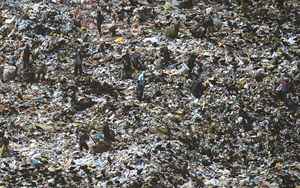(Finance) – Every hour, about 300 trucks full of waste enter the interior of the big landfill which collects garbage from the most populous urban area in all of Central America: Ciudad of Guatemala. Here, in what is called “zone 3 landfill” in the last 40 years a real community of people has developed who try to survive in conditions of extreme poverty, drawing the little necessary to live from what the rest of the city discards, namely waste. According to some estimates, over 30 thousand people live in the landfill in zone 3 today, crammed into precarious and makeshift housing, without access to running water. A extreme situation that the pandemic has made even more desperatecalling the international community to take action that is more necessary and quick than ever.
The story of the eighth chapter of BG4SDGs – Time to Change, the project by Stefano Guindani with Banca Generali to deepen the state of the art of the process of achieving the 17 objectives of the UN 2030 Agenda starts from this image. On this occasion, Stefano Guindani’s objective focused on investigating the situation relating to the Sustainable Development Goal (SDG) number 1 “Eliminate poverty in all its forms and everywhere“.
According to a report by the World Bank, in the world there are about 3 billion people living in urban areas and producing 1.3 billion tons of solid waste every year. In a planet whose climate cries out for more and more help, it is clear that reducing this waste is more than fundamental. Nevertheless in the world there are those who not only live there among the waste, but even count on it to be able to feed themselves.
In Central America, for example, the phenomenon of communities living in the basureros is constantly increasing in realities such as Haiti, Nicaragua, Honduras and Guatemala itself. In these places where tons of objects lie for decades waiting to complete their life cycle, entire social groups try to survive amidst garbage, debris, bad smells and the total absence of minimum hygienic conditions. Right there where the objects are abandoned to themselves without any recovery project, families of men, women and children try desperately to make it to the end of the day by recovering some leftover food or rags to dress with.
“It is strange to think that it is the well-being of the few that ruins the existence of the many but at the same time it allows its survival; in a way that is difficult to imagine, but it is only with the scraps of evolved society that even the Basureros can allow their families to survive “he commented Stefano Guindani, photographer and curator of the project.
According to data from the World Food Program – the United Nations agency that deals with food assistance – today there are 795 million people in the world living in conditions of absolute poverty. In other words, more than one in ten Earthmen live on less than $ 1.90 a day, the economic threshold that defines the difference between poverty and absolute poverty. The majority of these (42.7%) live in Sub-Saharan Africa but it is a phenomenon that is growing at all latitudes, also thanks to the pandemic that has aggravated the situation in Asia, Latin America and even in Europe.
In this context, it is evident that SDG number 1 is of crucial importance which is undoubtedly superior to all the other 16 objectives. Eradicating poverty is a priority of contemporary society, but synergies and international projects are needed. The most effective solution in the fight against poverty is linked to education, the only way to make people emerge from social contexts
economic depressed. Hence, projects such as those of the street schools in Haiti can prove decisive in orienting the future of entire generations in a brighter direction.
Presented last September 15, 2021 in Milan, BG4SDGs – Time to Change will now continue for another 9 months in order to deepen all 17 SDGs of the UN Agenda 2030. For each of them, the key adopted by the photographer will be twofold: on the one hand it aims to highlight the negative action of man on the environment and on the community, on the other hand how mankind itself has an extraordinary capacity for recovery through innovative and sustainable solutions. In his search, Guindani will go beyond the Italian borders, looking for critical cases and situations of excellence even abroad: Brazil, Norway and Australia, but also the United States, Turkey and South Africa. He is supported by an exceptional companion such as Alberto Salza, one of the most appreciated anthropologists at an international level, who will take care of the texts of the project and suggest some of the projects to be monitored.
